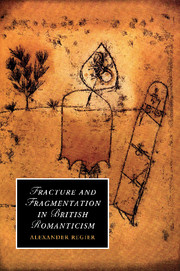Book contents
- Frontmatter
- Contents
- Acknowledgements
- List of abbreviations
- Broken origins: an introduction
- 1 A brotherhood is broken: Babel and the fragmentation of language
- 2 Figuring it out: the origin of language and anthropomorphism
- 3 Forces trembling underneath: the Lisbon earthquake and the sublime
- 4 A blue chasm: Wordsworth's The Prelude and the figure of parenthesis
- 5 Letters from the grave: John Keats's fragmented corpus
- 6 The doubling force of citation: De Quincey's Wordsworthian archive
- 7 Philological fractures: Paul de Man's Romantic rhetoric
- Notes
- Bibliography
- Index
- CAMBRIDGE STUDIES IN ROMANTICISM
7 - Philological fractures: Paul de Man's Romantic rhetoric
Published online by Cambridge University Press: 06 July 2010
- Frontmatter
- Contents
- Acknowledgements
- List of abbreviations
- Broken origins: an introduction
- 1 A brotherhood is broken: Babel and the fragmentation of language
- 2 Figuring it out: the origin of language and anthropomorphism
- 3 Forces trembling underneath: the Lisbon earthquake and the sublime
- 4 A blue chasm: Wordsworth's The Prelude and the figure of parenthesis
- 5 Letters from the grave: John Keats's fragmented corpus
- 6 The doubling force of citation: De Quincey's Wordsworthian archive
- 7 Philological fractures: Paul de Man's Romantic rhetoric
- Notes
- Bibliography
- Index
- CAMBRIDGE STUDIES IN ROMANTICISM
Summary
To connect highest scrupulousness with greatest brutality.
COHERENT FRACTURES
This final chapter wants to take the reader into our Romantic present. It will do so by discussing the purchase fracture and fragmentation have as critical notions in contemporary theorisations of Romanticism. A small selection of texts by Paul de Man will be my main focus. His writings provide an important case for illustrating how fracture and fragmentation function both as critical and as heuristic categories in and for Romantic Studies. In this sense, the chapter is another case study, albeit focusing on texts that are historically situated in the late twentieth century. To argue that this approach is fruitful as well as methodologically sound already reveals part of the assumptions and conclusions that are at stake here. The introduction indicated why there are good reasons to understand de Man and other figures as forming, in significant ways, part of the historical projection termed ‘Romanticism’. This not only relates to de Man as one of the most influential figures in the construction and theorisation of this very category. More importantly, it is to understand him as a figure of Romanticism. This is not a matter of simply equating de Man's writings with their Romantic subjects. Rather, it is a question of aligning them in a meaningful trajectory. An insight into certain parallels and affinities (only sometimes elective) between them improves an understanding of how they function as historical and conceptual categories.
- Type
- Chapter
- Information
- Fracture and Fragmentation in British Romanticism , pp. 165 - 186Publisher: Cambridge University PressPrint publication year: 2010

